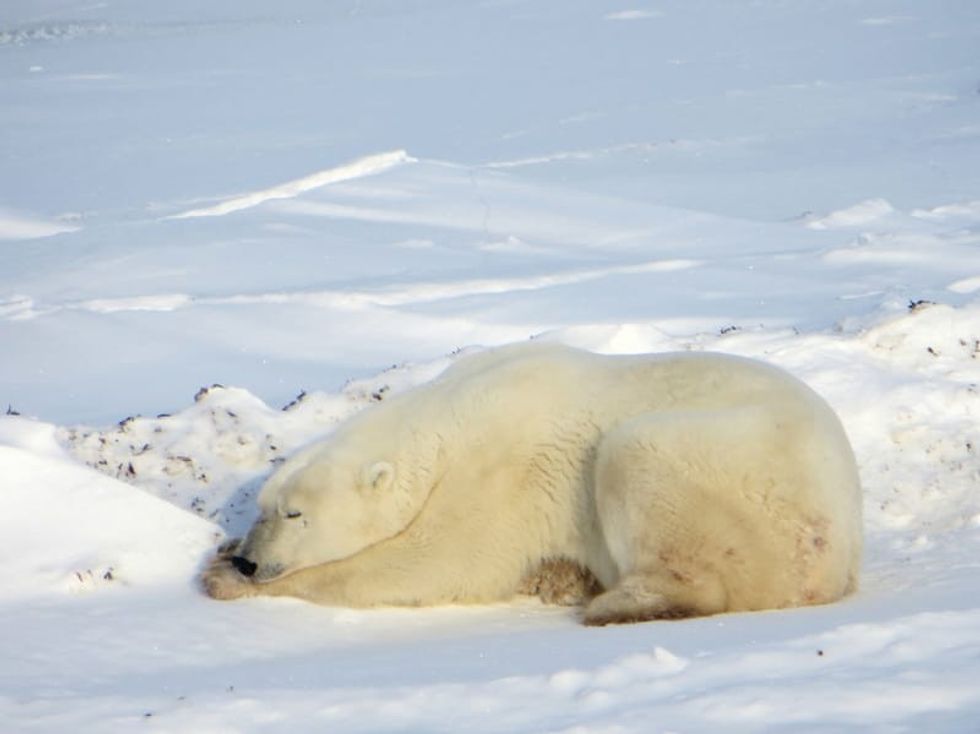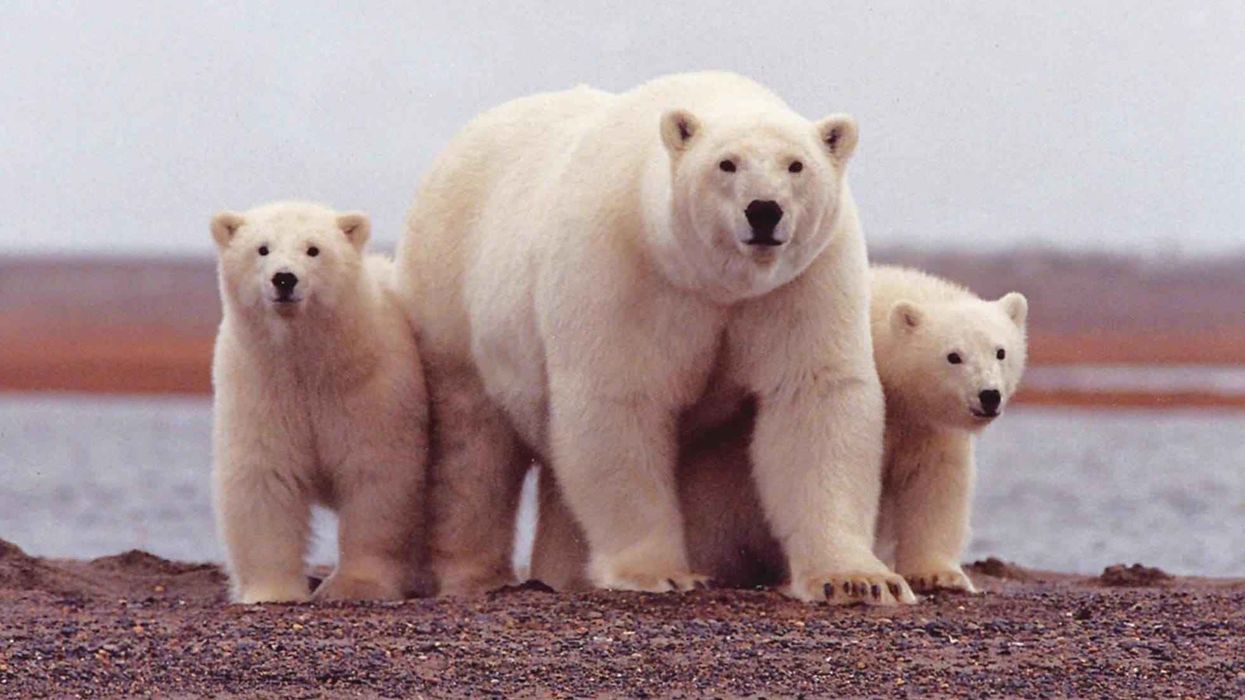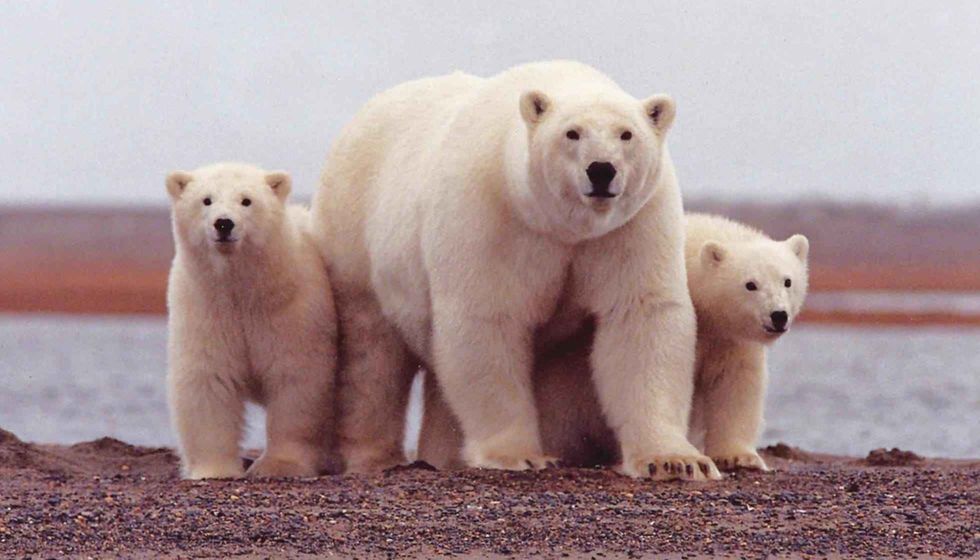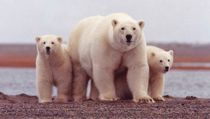Fun Polar Bear Facts For Kids

Content
- What type of animal is a Polar Bear?
- What class of animal does a Polar Bear belong to?
- How many Polar Bears are there in the world?
- Where does a Polar Bear live?
- What is a Polar Bear's habitat?
- Who do Polar Bears live with?
- How long does a Polar Bear live?
- How do they reproduce?
- What is their conservation status?
- What do Polar Bears look like?
- How cute are they?
- How do they communicate?
- How big is a Polar Bear?
- How fast can a Polar Bear move?
- How much does a Polar Bear weigh?
- What are their male and female names of the species?
- What would you call a baby Polar Bear?
- What do they eat?
- Are they dangerous?
- Would they make a good pet?
- Did you know...
- What animal can kill a Polar Bear?
- Can eating Polar Bears kill you?
Do you want to know about a unique creature found in the Arctic area? Then you must read up about the Polar Bear.
Polar Bears are bears that are endemic to the Tundra area. These bears with their white physical appearance make for a majestic sight in the snow-covered mass of the Arctic. Their scientific name Ursus maritimus, when literally translated, means sea bear.
These bears are known to be apex predators who mainly hunt seals through breathing holes. They wait for the seal to pop out of the breathing hole before pouncing on them.
Found in areas such as Russia, Greenland, Svalbard, Hudson Bay, Polar Bears are under some level of threat. This is due to climate change and the loss of habitats. However, efforts have been made to conserve them from going extinct.
So read on for more information on these bears. For more bear fact files, take a look at sun bear and brown bear facts.
Polar Bear Interesting Facts
What type of animal is a Polar Bear?
The Polar Bear (Ursus maritimus) is a type of bear that is found in the sea ice of the Arctic Ocean and in some countries along the Arctic Circle. These marine mammals are considered to be close relatives of brown bears.
What class of animal does a Polar Bear belong to?
Polar Bear (Ursus maritimus) is a bear species that belongs to the class of Mammalia. These marine mammals have the family classification of Ursidae.
How many Polar Bears are there in the world?
To estimate the population of the Arctic Polar Bears can be a difficult endeavor. Different sources suggest different Polar Bear populations. It can be said that the total population of the Ice Polar Bears can range between 22,000-31,000. Recent estimates by researchers give a more accurate figure of the Polar Bear population to be around 26,000.
Where does a Polar Bear live?
As is clearly evident from their name, Polar Bears are from the Polar regions of the Arctic Circle. They are found on the ice floe and sea ice of the Arctic Ocean, along with inhabiting some countries that lie in the Arctic Circle or the Tundra Zone.
This Polar Bear range of land territories is Russia, Greenland, Alaska, northern areas of Canada, and Svalbard of Norway.
However, where they live also depends on how the ice melts in different regions. In places like the James Bay or the Hudson Bay, the ice is known to melt faster causing the Polar Bears to travel to the land in the summer.
They wait for the ice to freeze before returning from the ice-free areas.
In some areas of Russia, these bear species have been observed traveling further north in the summer in search of frozen sea ice, rather than returning to the land south. Researchers have found that these close relatives of the brown bears do not really prefer living in northern parts of the Arctic.
What is a Polar Bear's habitat?
The preferred habitat of a Polar Bear is that of the sea ice mass and the land areas along the Arctic Circle. This has been termed the Arctic Ring of Life.
Since they live in primarily cold areas, Polar Bears have made certain adaptations to fit into the Arctic life with its snow and low wildlife. Polar Bear swimming is one such adaptability.
These bears can swim from one ice mass to the other and are known to be great divers and swimmers. Their ability to swim and hunt has made them apex predators in the Tundra.
All their other abilities have closed dependability on the ice. Relying on the ice habitat, Polar Bears hunt seals and travel in order to survive. However, survival might be difficult if their stay in ice-free zones exceeds their period of fasting.
Polar Bears are also well adapted to the bitter cold. They have two layers of furs along with the third layer of fat which keeps them warm.
Polar Bears have also been observed to dig snow pits in the ice in order to survive through windy days of cold. These are some Polar Bear habitat facts.
Who do Polar Bears live with?
Although known to be solitary animals, Polar Bears have been found to enjoy close friendships within their kind, especially males. Sometimes, many Polar Bears develop a playful relationship with the other and have even been observed resting with each other in an embrace.
Females are not solitary when breeding and raising Polar Bear cubs. The relationship between the female Polar Bears and the cubs is important. Polar Bears also appear to be in a group when in pursuit or during the sharing of a substantial food source.
How long does a Polar Bear live?
Polar Bears are known to live around 20-25 years in age. The highest recorded Polar Bear lifespan was a captive female Polar Bear who died at the age of 43. While on the other hand, there hasn't been a single case of Polar Bears living for more than 32 years in the wild.
How do they reproduce?
Polar Bears are one of the several species in which males court females. The period of courtship goes around between the months of April and May.
Males usually swim or travel to follow the females and are known to engage in violent physical fights with other male Polar Bears in order to gain mating rights. The male and the female then engage in multiple mating sessions because Polar Bears have induced ovulation. Once the mating is completed, males leave.
Female Polar Bears become pregnant during the fall. Pregnant females need to survive the cold winter full of snow.
They do this by digging in dens in the ice or the snow. These dens are the places where the females rest before giving birth in the months between November and February.
Usually, a den is situated on land areas near the coastlines. Interestingly, pregnant females can continue reusing the den for further mating cycles. The female gives birth to two cubs in the den.
Usually, the mother doesn't leave the two cubs in the den for about two weeks during the Polar Bear Cubs are fed fat-filled milk. The cubs are usually born blind and are covered with light fur.
What is their conservation status?
There is a misconception that Polar Bears are endangered species. Although they are not far from being endangered, these bears have not been classified as such.
The International Union For Conservation Of Nature places them in the category of Vulnerable on their Red List. The number of Polar Bears might be decreasing due to their loss of habitats and pollution. Oil spills play a major part in decreasing the numbers of seals in the Tundra wildlife which are major food sources of the Polar Bears.
Hunting for Polar Bear fur also causes a decrease in their numbers. Climate change and global warming also contribute to their decreasing numbers.
Polar Bear Fun Facts
What do Polar Bears look like?
Polar Bears have the most unique appearances amongst bears. The Polar Bear face is longer and narrower than normal bears.
Their muzzle is bigger too. Elongated necks are also a part of their physical features.
In order to conserve heat, Polar Bears have many adaptations. They have short ears and short tails. The length of the tail hardly ever exceeds 2.8-5.8 in and is considered to be the shortest amongst all bear species.
Their legs are stocky and males have ornamental hair on the hind legs to attract the attention of females. Their leg pads have also gone through evolution to be adapted to the ice, snow, and sea conditions.
Their feet and paws are large so that it helps them in distributing weight equally while traversing through thin or thick ice and snow in search of food and seals. The Polar Bear paw, especially the hind paw, also helps the Polar Bears in swimming helping them in propulsion through the waters.
The fur of the Polar bears might be the most distinct feature of them. The Sea Bear, as they were known earlier, have two layers of fur and a layer of fat to help them keep warm in the snow-covered landmass of the Tundra.
However, the Polar Bears' white fur is not really white but translucent. This translucent guard hair might be the biggest talking point in the Polar Bear vs Grizzly debate.
Below this fur of guard hair is actually a black fur.
This black Polar Bear skin in turn covers the thick layer of fat tissues. This layer of body fats acts as a great insulator of heat when the Polar Bear swims across the sea.
Wet layers of furs do not provide warmth to the bears once they are back on the sea ice. However, importing their furs is banned in many countries and thus you might find it very difficult to find a hairless Polar Bear showing just their black skin.

How cute are they?
A cute Polar Bear could be any specimen of these species. Their unique appearances amongst all the other wildlife can lead to them being called cute. What also adds to their cuteness quotient is their propensity to be playful.
Polar Bear cubs are very playful and often imitate their mothers hunting habits while hunting for food and seals and other prey. A tiny Polar Bear baby can be very adorable. The image of a swimming Polar Bear might also be deemed adorable or cute by some.
How do they communicate?
Polar Bears are generally thought to be quiet animals. They only communicate with each other through some vocalization and sounds.
The sense of smell in Polar Bears is very acute. Males often track females by the smell of the tracks left in the snow. This may be due to the climate conditions where olfactory senses have evolved instead of vision.
Growls, hisses, and roars are usually seen as signs of aggression from Polar Bears while chuffing and snorting might be an indication of stress, fear, and nervousness. The common distress call amongst the young adults and the cubs is bleating, while mothers communicate with their cubs through chuffs and moans and grunts.
How big is a Polar Bear?
The Polar Bear size is usually quite large. Polar Bears can grow up to 5-10 ft when measured while standing on their hind legs. The Polar Bear height measured at the shoulder is usually between 4-5.5 ft.
There is a significant size difference between the two genders with males being bigger. While standing up, Polar Bears are easily twice the size of an average human being. The largest Polar Bear ever caught was measured to be more than 11 ft tall when mounted on its rear legs.
How fast can a Polar Bear move?
The speed of Polar Bears is usually slow when walking on sea ice. Their speed on sea ice is around is 3-4 mph.
However, it is not that Polar Bears cannot run fast. They are known to reach speeds of 24 mph but can often be found roaming around at a leisurely pace. These animals tend not to run too much because of the issue of overheating in their body.
While running, Polar Bears heat up quite fast. On the other hand, the swimming speeds of the Polar Bears can reach up to 6 mph.
How much does a Polar Bear weigh?
The Polar Bear weight is quite remarkably high in comparison to other wildlife. They exhibit a very high level of sexual dimorphism, which is only second to seal species. Females are around half the size of males.
The average weight of the Polar Bears can range from 300-1500 lb. The heaviest Polar Bear ever caught was weighed to be around 2,250 lb. This enormous weight range can be attributed to the heavy amount of fats stored in their bodies.
What are their male and female names of the species?
There are no distinct names for the male and female Polar Bears.
What would you call a baby Polar Bear?
In a similar fashion, Polar Bear cubs do not have special names and are usually referred to as cubs.
What do they eat?
Polar Bears are considered to be apex predators or keystone species and are at the top of the Tundra food pyramid. They mainly prey on different types of seal species such as the Ringed Seal and the Bearded Seal.
Apart from their ability to hunt seals, Polar Bears also prey on other wildlife present in the snow-covered sea ice such as birds and muskox. The Polar Bear diet may also include Reindeers and some plants.
Are they dangerous?
Polar Bears must be considered dangerous because they are fearless of humans. Climate change has affected their food habits and instead of the sea ice, they are now coming perilously close to human settlements in hunt of food. Although a Polar Bear attack on humans is seldom recorded, we must remember these bears are indeed carnivores.
Would they make a good pet?
Due to being native to the colder regions and being carnivores in nature, Polar Bears should never be kept as pets.
Did you know...
There was an account of a Polar Bear swimming 400 mi in nine days in the Bering Sea. This particular female traveled a further 1,100 mi in search of sea ice. It was estimated that she lost around 22% of her body fat during the journey.
To approach seals onshore or on ice floes, the polar bears can swim for up to three minutes underwater.
An Albino Polar Bear is not known to exist. But, if they do, theoretically their white skin might not be able to combat the cold climate of the Tundra.
There have been hybrids produced between Polar Bears and Grizzly Bears and most of them are fertile.
What animal can kill a Polar Bear?
Due to being at the top of the food chain, Polar Bears do not have any natural predators. They are usually killed by other Polar Bears in a fight. Young cubs may be attacked by wolves. In a bid for survival, Polar Bears show cannibalism and can eat other adults or cubs.
Can eating Polar Bears kill you?
Most parts of the Polar Bear are edible except the Polar Bear liver. In earlier days of Polar Bear hunting, the liver was left out due to it being poisonous, containing high levels of Vitamin A. As they feed on the seal which in turn consumes fish, Polar Bears are known to ingest high amounts of Vitamin A.
Here at Kidadl, we have carefully created lots of interesting family-friendly animal facts for everyone to discover! Learn more about some other mammals including muskox, or Kodiak bear.
You can even occupy yourself at home by drawing one on our Polar Bear coloring pages.
We Want Your Photos!
More for You
See All
Bachelor of Arts specializing in Journalism and Mass Communication, Postgraduate Diploma in Sports Management

Moumita DuttaBachelor of Arts specializing in Journalism and Mass Communication, Postgraduate Diploma in Sports Management
A content writer and editor with a passion for sports, Moumita has honed her skills in producing compelling match reports and stories about sporting heroes. She holds a degree in Journalism and Mass Communication from the Indian Institute of Social Welfare and Business Management, Calcutta University, alongside a postgraduate diploma in Sports Management.
Bachelor of Law

Abdulqudus MojeedBachelor of Law
A versatile professional with a passion for creative writing and technology. Abdulqudus is currently pursuing his Bachelor of Law from the University of Lagos and has experience as a tutor, intern assistant, and volunteer. He possesses strong organizational skills and is a detail-oriented person.
Disclaimer
1) Kidadl is independent and to make our service free to you the reader we are supported by advertising. We hope you love our recommendations for products and services! What we suggest is selected independently by the Kidadl team. If you purchase using the Buy Now button we may earn a small commission. This does not influence our choices. Prices are correct and items are available at the time the article was published but we cannot guarantee that on the time of reading. Please note that Kidadl is a participant in the Amazon Services LLC Associates Program, an affiliate advertising program designed to provide a means for sites to earn advertising fees by advertising and linking to Amazon. We also link to other websites, but are not responsible for their content.
2) At Kidadl, we strive to recommend the very best activities and events. We will always aim to give you accurate information at the date of publication - however, information does change, so it’s important you do your own research, double-check and make the decision that is right for your family. We recognise that not all activities and ideas are appropriate for all children and families or in all circumstances. Our recommended activities are based on age but these are a guide. We recommend that these ideas are used as inspiration, that ideas are undertaken with appropriate adult supervision, and that each adult uses their own discretion and knowledge of their children to consider the safety and suitability. Kidadl cannot accept liability for the execution of these ideas, and parental supervision is advised at all times, as safety is paramount. Anyone using the information provided by Kidadl does so at their own risk and we can not accept liability if things go wrong.
3) Because we are an educational resource, we have quotes and facts about a range of historical and modern figures. We do not endorse the actions of or rhetoric of all the people included in these collections, but we think they are important for growing minds to learn about under the guidance of parents or guardians.







